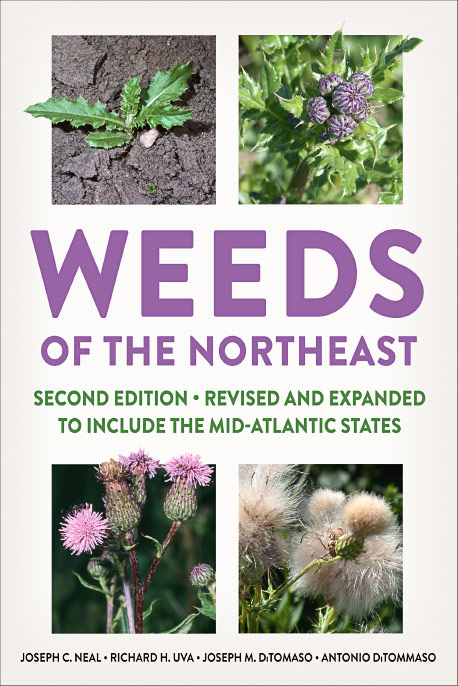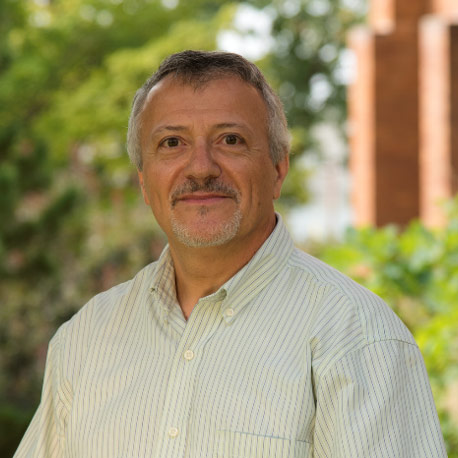Weeds of the Northeast
Recorded September 21, 2023
Download presentation slides (PDF, 4 MB)
Related Links

Weeds of the Northeast – 2nd Edition (Cornell Univ. Press).
- Weeds of the Northeast (Second Edition)
- Manage Weeds on Your Farm (PDF, 12 MB)
- Cornell’s Weed Science Teaching Garden
Q and A
Q. How do you eradicate Japanese stiltgrass? It’s incredibly invasive and fortunately can be picked out of plants rather easily, but I’d love to know how to get rid of it without hurting bees, butterflies, etc.
A. See this resource: extension.psu.edu/japanese-stiltgrass
It will take over 5 years because of seed banks. Try pre-emergent herbicides to control seed germination.
Q. Getting rid of Ailanthus—any ideas?
A. See this resource: extension.psu.edu/tree-of-heaven-control-strategies
There’s information here, too: extension.psu.edu/tree-of-heaven – and if you’re concerned about spotted lanternfly, you can check out StopSLF.org.
Q. Does the book have what native can compete with each invasive such as jewelweed can complete with knotweed?
A. See this resource: extension.psu.edu/japanese-knotweed
I have treated Japanese knotweed in early September with glyphosate in forest understories and found jewelweed coming in the next year. Must treat the knotweed with herbicides for about 3 years and then you will get natives coming back.
Q. Do you have any information on lesser celandine control?
A. See this resource: extension.psu.edu/dont-be-deceived-by-this-beguiling-springtime-plant
Q. How do you get rid of wild honeysuckle?
A. See this resource: extension.psu.edu/shrub-honeysuckles
Q. Can one make biofungicide for a home orchard by grinding up Japanese knotweed?
A. One reference: www.ncbi.nlm.nih.gov/pmc/articles/PMC7709458/
Also, try REGALIA. It has an EPA label and is an OMRI product.
Q. What is Antonio’s email address?
A. Antonio DiTommaso: ad97@cornell.edu
Description
Toni DiTommaso introduces the new edition of his comprehensive reference book, Weeds of the Northeast, and answers your weed related questions.
The new edition covers 500 common and economically important weeds in the region south to North Carolina, north to Maine and southern Canada, and west to Wisconsin. This practical guide includes descriptions and photos of floral and vegetative characteristics, giving home gardeners, landscape managers, pest management specialists, and allergists the ability to identify weeds before they flower.
Antonio DiTommaso

Antonio DiTommaso, Professor and Chair, Soil and Crop Sciences Section, School of Integrative Plant Science, Cornell University.
Antonio (Toni) DiTommaso is a Professor of Weed Science and Chair of the Soil and Crop Sciences Section in the School of Integrative Plant Science at Cornell University. Dr. DiTommaso received his B.S. in Environmental Sciences (1986) and Ph.D. in Weed Ecology (1995) from McGill University in Montreal, Canada, and M.S. in Plant Ecology (1989) from Queen’s University in Kingston, Ontario, Canada. He joined Cornell as an Assistant Professor in 1999.
DiTommaso’s primary areas of scholarship focus on the biology, ecology, and management of important agricultural weeds and introduced invasive plants of natural and semi-natural areas in the northeastern U.S. and southern Canada. His most recent work focuses on the impact of climate change on the ecology and range expansion of weedy and invasive species and on crop-weed interactions.
DiTommaso has published over 145 scientific articles and 12 book chapters. Most recently, he is a co-author of the book: Weeds of the Northeast – 2nd Edition (Cornell Univ. Press) and Manage Weeds on Your Farm: A Guide to Ecological Strategies (SARE). He has served as Editor-in-Chief of the scientific journal Invasive Plant Science and Management since 2015.
In 24 years at Cornell, more than 1,350 undergraduate and 75 graduate students have enrolled in Dr. DiTommaso’s weed science and integrated pest management courses.
